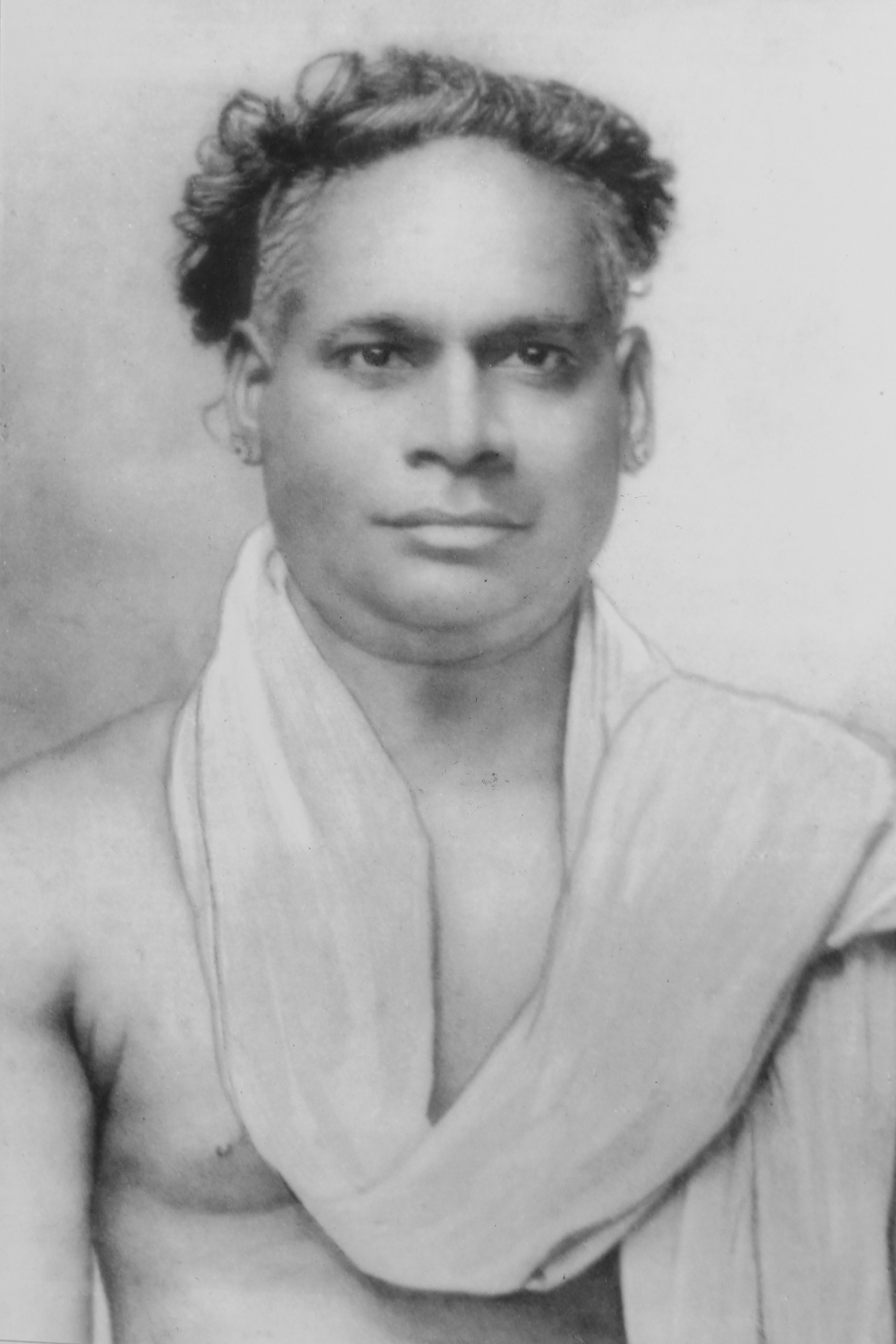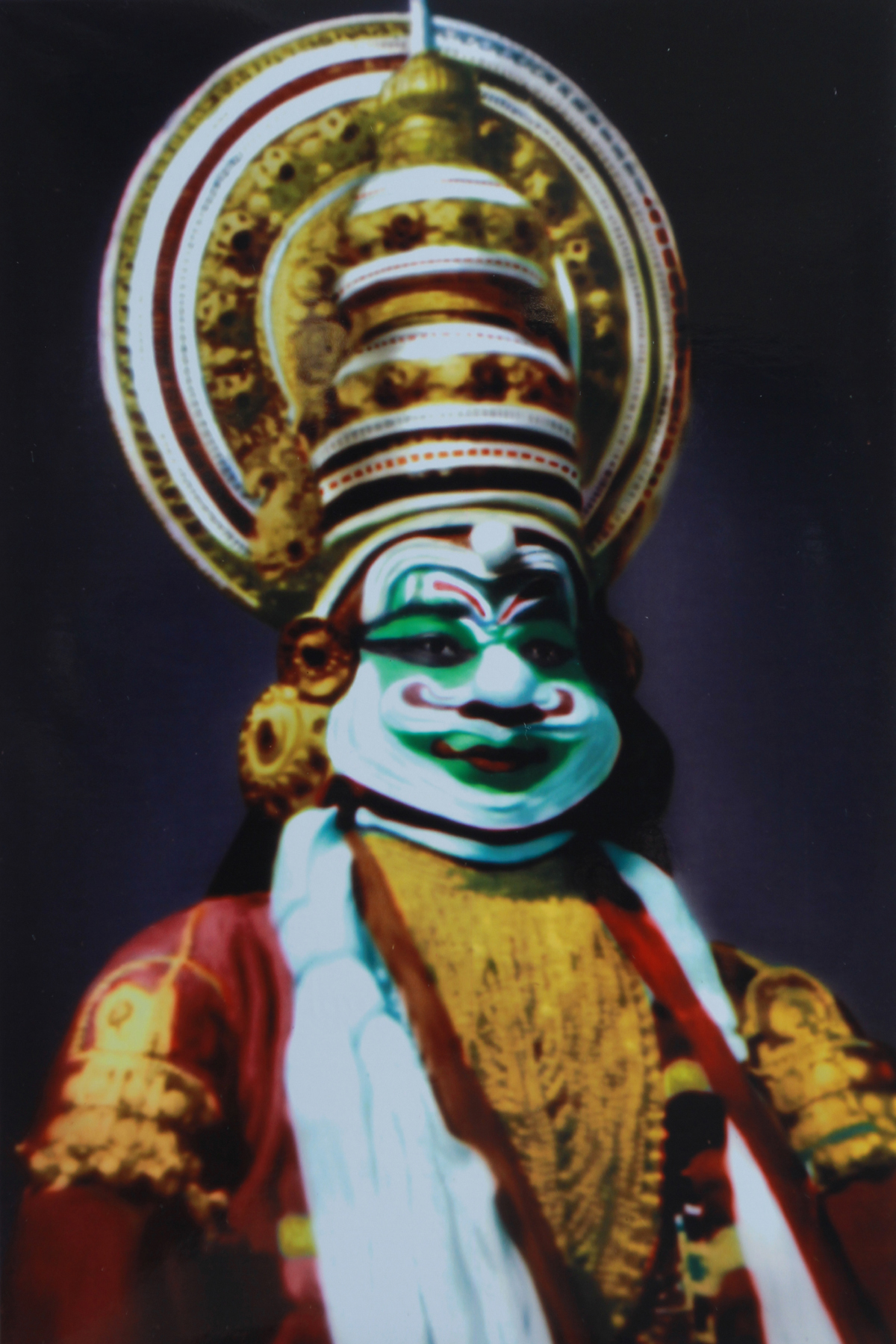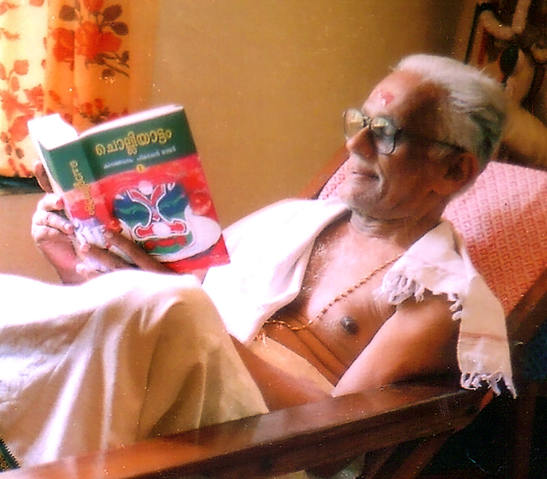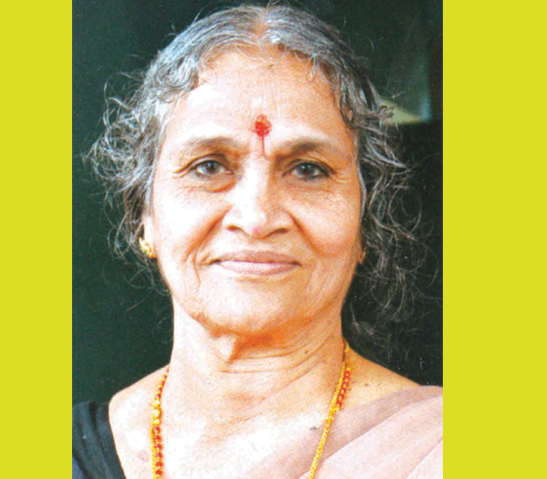


Pattikkamthodi Ramunni Menon (1880–1948) was a pivotal figure in the history of Kathakali, having played a crucial role in remoulding and refining its grammar in the famed Kalluvazhi tradition of the classical dance-drama from Kerala in south India.[1] He was trained in the art form at a culture-patronising Namboodiri mansion in Vellinezhi near his home, even as his genius ensured that Menon later redrew the aesthetics of Kathakali and its future profile altogether.
Young Ravunni, a native of Chethallur in present-day Palakkad district, was groomed in Kathakali by the renowned Kalluvazhi Kuyilthodi Ittirarissa Menon at Olappamanna Mana with Kariyattil Koppan Nair and Malankattil Sankunni Nair as his co-students.[2] Ittiraricha Menon's demise led to Ravunni Menon becoming the chief tutor at Olappamanna, since when he started handling lead roles (Aadyavasana vesham) on Kathakali stages. He was initially associated with the Manjeri Kaliyogam (Kathakali institution-cum-troupe).
Menon, who was till then said to be focused solely on the body movement aspect of Kathakali, acquired a major asset in his profession when he imbibed the essence of emotive acting (rasabhinaya) under Kunjunni Thampuran. It gave birth to a new chapter in the Kalluvazhi style, noted for its economy of space while moving the body, well-defined hand gestures, their clinical synchronisation with the musical beats and percussion accompaniment. This quantum improvement later helped him earn quite a few epoch-defining Kathakali disciples when he joined Kerala Kalamandalam in 1933 and worked there for a decade.[3] Prominent among the pupils are Thekkinkattil Ramunni Nair, Vazhenkada Kunchu Nair, Kalamandalam Krishnan Nair, Keezhpadam Kumaran Nair, Kalamandalam Ramankutty Nair and Kalamandalam Padmanabhan Nair (who was also his son). He was also teacher to reputed artistes like Mampuzha Madhava Panikkar, Kavungal Sankarankutty Panikkar, Kariyattil Kumaran, Kunhunni Nair, Guru Gopinath, Madhavan, Guru Kelu Nair, Sivaraman, Sivasankaran, Krishnan, Kattissery Raman, Balakrishnan and Krishnankutty Varrier.
Menon, known for his temperamental behaviour stemming from innocence, was a purist of sorts. He was a pedagogue to the core—unkind while punishing pupils in the classroom even while exhibiting retrained love to them after study hours.
On the stage, Menon was celebrated for his lead roles in the four Kottayam Thampuran plays: Kalakeyavadham, Kirmeeravadham, Bakavadham and Kalyanasougandhikam. His masterpieces also included Dakshan, Nalan in Nalacharitan Randaam Divasam, Arjunan in Subhadraharanam, Cheriya Narkasuran and Ravanan in Balivijayam, Ravanolbhavam, Kartaveerarjunavijayam and Balivadham besides minukku roles like Bhrahmanan in Santanagopalam and Rukminiswayamvaram, and Durvassavu in Ambareeshacharitam. He was known to be particular for using his own set of costume paraphernalia (kalikkoppu) all the time.
Menon's notes on the aeshtetics of Kathakali have been published in a book, which has also formed material for art research scholars.
"The modern history of Kathakali begins where the life history of Pattikkamthodi ends. “As life expectancy during his time was relatively low, at the age of 68 he was bed-ridden. Though he was sure that he had reached the end of his life, which was devoted to Kathakali for almost six decades, his only desire was to perform one last time with his specially made and renovated head-gear,” his eldest son and last disciple, the late Kalamandalam Padmanabhan Nair (1928-2007), former Principal of Kerala Kalamandalam was quoted as saying" according to KK Gopalakrishnan, (Director of the Centre for Kutiyattam of the Central Sangeet Natak Akademi, Delhi)

Guru Sri. Kalamandalam Padmanabhan Nair is one among the very few top most Kathakali acharya hailed by connoisseurs in India and abroad. An internationally reputed artiste, who performed in most of the foreign countries, he is also considered as the leader among the Gurus who upheld the traditional Kalamandalam style of Kathakali, perfected by his father and legendary maestro late Pattikkamthodi Ravunni Menon.
Born on October,7,1928 at Kuruvattoor in Palakkad district of Kerala, to Cherukandath Ammukutty Amma and Natyacharya Pattikkamthodi Ravunni Menon, when he was ten years old, his father took him to Kerala Kalamandalam to impart training in Kathakali acting under the patronage of Kerala poet laureate Vallathol Narayana Menon. For a few years he was trained from Kottakkal P.S.V. Natyasangham too, when his illustrious father took an assignment there. This unparalleled training made him a talented and faultless performer as well as an acharya of Kathakali at a relatively young age, which compelled Vallathol to offer him an appointment in the faculty of the Kerala Kalamandalam in 1951.
After serving at the Kerala Kalamandalam for 38 years, starting as an instructor and later as Professor, he retired in 1989 as Principal. Most of the offsprings of the Kalamandalam graduated during those period are groomed by him. Kalamandalam, primarily being a training institution, there was a period in his career where he gave more emphasis for grooming disciples than performing and this gave birth to several leading Kathakali performers of today who had won international acclaim and recognition later.
Padmanabhan Nair handled almost all the hero characters. He had a special instinct to perform the roles hallmarked by rigid techniques and grammer. All the characters in “Kathi” (Ravana, Duryodhana, Keechaka etc.), the “Brahmin” of “Santhanagopalam”, “Hamsa” of Nalacharitham, etc.had earned a unique charm when he handled. His performance as Arjuna of “Kalakeya vadham”, Dharmaputhra of “Kirmeera vadham” and Bheema of “Kalyanasougandhikam” (all in ‘Pacha” type) are known for technical perfection and excellent artistry, very much to the praise of the learned connoisseurs of the art. His “Cholliyattam” (Kathakali acting without costume) of almost all the important stories were documented in 1985 for the Kalamandalam library, for the use of both students and upcoming artists of Kathakali which is an invaluable archive for the future generations of the art. The Central Sangeet Natak Academy also has documented his performance. He was one of the chief choreographers of the story “King Lear” into Kathakali and also acted as King Lear, the hero character which was staged in the Shakespear’s Globe theatre in London for a series of weeks, in 1999.
Padmanabhan Nair is the author of two classic text books (‘Kathakali Vesham’ – Volume I & II), the bible for Kathakali teachers and students, which is now recognized as the basic teaching manual in all the Kathakali institutions. He has also written another authentic book in two volumes comprising the complete acting manual (‘attaprakara’) of sixteen stories known for rigid grammer and techniques, under the Senior fellowship of the Department of Culture, Govt. of India (1983), which was published by the Kerala Kalamandalam in 2000. None of the Kathakali acharyas became successful in this strenous endeavour, except this illustrious maestro and scholar.
In 1992, Sri. Padmanabhan Nair was awarded the Central Department of Culture’s Senior fellowship to write a book on his late father Pattikkanthodi Ravunni Menon and to publish his rare notes on Kathakali. This was published in 2004, which also won the Odakkuzhal Puraskaram for Malayalam literature in 2005. He was the first recipient of the coveted Kalamandalam award for Kathakali when it was instituted in 1979. In 1992, the Kerala Sangeet Natak Akademy award and in 1994, the Central Sangeet Natak Akademy award came in search of him. He was also honoured by most of the Kathakali Clubs in Kerala with awards and receptions, and was also presented the Kathakali award of the Govt.of Kerala in 2006.
Smt. Kalamandalam Sathyabhama, the veteran Guru of Mohiniyattam and the former Principal of Kerala Kalamandalam was his life partner.
This legendary maestro who had dedicated his life for Kathakali as a Karma Yogi passed away in 2007 at the age of 78, and his demise marks the end of an era in Kathakali.
Prolific Writer


Padmasri Kalamandalam Sathyabhama, the chief architect of Mohiniyattam as seen today, was an acclaimed choreographer and widely venerated guru of this lasya – rich dance form of Kerala. She was born in 1937 at Shoranur, a village in Palakkad district to Sri. Krishnan Nair and Venat Ammini Amma. Her passion for dance made her to join Kerala Kalamandalam as a student in 1949 at the age of 12 after completing 8th standard in school as the Malayalam poet laureate Vallathol, the founder of Kerala Kalamandalm was struggling to revive Mohiniyattam which was almost lost to Kerala few decades ago. Sathyabhama had her intensive lessons in Mohiniyattam under guru Thottassery Chinnammu Amma who was appointed by Vallathol at the Kalamandalam as she was the only available inheritor of the old Mohiniyattam tradition. Guru Chinnamu Amma taught Sathyabhama the rudiments of Mohiniyattam though it was confined to a handful of adavus and a few items like Cholkettu, Jathiswaram, Varnam and Padam as the teacher herself had forgotten a lot of what she had learnt. Along with Mohiniyattam, Sathyabhama also trained in the female roles of Kathakali under the veteran guru Kalamandalam Padmanabhan Nair, a faculty of Kathakali at Kalamandalam those days who later turned her spouse.
Saddened by the poor repertoire of Mohiniyattam insufficient for full-fledged recitals, Sathyabhama made up her mind to rejuvenate and enrich the art after she was appointed as a teacher in Dance department in 1957 by poet laureate Vallathol himself. Her pioneering effort was to compose more adavus for Mohiniyattam but without going against the essential characteristics of the form and thus she could formulate around 35 adavus afresh. Simultaneously she ventured into Choreography too which led to the composition of around 20 items especially Padams and Varnams to her credit for which she could successfully enlist the support of her colleagues in the Dance department as well as scholars in other departments including her husband Sri. Padmanabhan Nair. Today all these adavus and items are considered as the very base of Mohiniyattam which are used for grooming Mohiniyattam dancers across the world, leave alone the Kerala Kalamandalam. Almost all the, except four or five, Mohiniyattam practitioners of our times– from veteran Gurus and performers to up and coming up artists- are either her direct disciples or grand and great grand disciples.
Her own significant choreographies
| Varnams | Ragam |
|---|---|
| Danisamajendra gamini | Todi |
| Manasime parithapam | Sankarabharanam |
| Suma sayaka | Kappi |
| Ahantha vanchithaham | Dhanyasi |
| Padams | Ragam |
| Pannagendra Sayana | Ragamalika |
| Panimathimukhi Bale | Aahari |
| Taruni Nhan Enthu Chaivoo | Dwijavanthi |
| Kanthanodu Chennu Melle | Neelambri |
| Viditham the Nisavritham | Surutti |
| Karuna chaivan Enthu Thamasam | Ragamalika |
| Kantha Thava Pizha Nhan | Atana |
| Ilathalir Sayane | Punnagavarali |
| Kanakamaya mayidunna | Useni |
| Sundara srunu kantha | Arabhi |
| Panchabhanan Thannudaya | Kambhoji |
| Thillana | Parasu |
| Kuchelopakhianam ( Dance Ballot) | Ragamalika |
| Radhayude kritharthatha (By Vallathol) | Ragamalika |
Thus the diminutive repertoire of Mohiniyattam was expanded by adding around 20 items which was widely acclaimed by the connoisseurs of the dance form as her phenomenal contribution to the art. They were staged all over the world by her disciples and grand disciples earning name and fame for this dance of enchantress which was at a time banished by the Kerala society for the stigma attached to dancing.
Innovations
One of the major innovations that Sathyabhama contributed was in the coiffeur, by introducing the ‘ Kondakettu’ for the dancer to make it on par with the cultural tradition of Kerala. Later innovations brought by her were into the framework of bhavabhinaya and subtle body movements by imbibing new aesthetical elements without harming the individuality of Mohiniyattam.
The relentless and painstaking efforts made by her as a performer, teacher, innovator and choreographer accorded a well-knit structure for the Mohiniyattam which was widely recognized and acknowledged as the “ Kalamandalam Style’ later. Thus she is hailed as the living mother of Mohiniyattam.
The noble task of transforming Mohiniyattam, once alienated by the society, to a totally enchanting one through the Kerala Kalamandalam has been her major contribution to the art. The costume and jewellery of Mohiniyattam seen today are also a contribution of the “ Kalamandalam style’ , her baby.
As an accomplished performer, Sathyabhama had proved her inimitable artistry during her student days at the Kalamandalam. She was a member in the Kalamadalam troupe that toured Malaysia and Singapore in 1952 along with Vallathol. After serving Kerala Kalamandalam for about 36 years as teacher and later as the head of its Dance department, she retired from service in 1993 as Principal proving her skill as an administrator as well. Interestingly, all her students who have established themselves as outstanding teachers and performers in Kerala and outside are scrupulously following the same Kalamandalam style conceived and nurtured by this doyenne of Mohiniyattam. All the leading Gurus and practitioners of Mohiniyattam are either her direct disciples or grand disciple, like Kalamandalam Kshekavathy, Vimala Menon, Saraswathy, Sugandhi, Leelamma and Hymavathy to name a few. She passed away on 13th Sept, 2015 leaving a big emptiness in the cultural scenario of Kerala.
